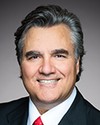You hit the nail very much on the head. The market forces have played a huge factor in this.
When the industry started lobbying for seat belts back in the early 2000s, it was because we were getting a lot of pressure from our customers to have coaches with belts and they wanted to know what the standard should be. That's why we wanted the government to adopt a standard: we wanted to know what to build.
A seat belt is more complicated that just a couple of strips of nylon. It has to fit a certain engineering standard for how many Gs of force it can withstand and all that, and nobody wanted to put in 10G belts when the government was going to come along later and mandate 12G belts.
That's why we wanted the manufacturing standard and also why coaches started being built and bought with belts on them already, even though there was no government regulation. It was because of those market forces.
That's accelerating now. For many of our members, it's not a regulatory issue, it's a marketplace issue. Particularly because of Humboldt, there's a lot more attention around it. Whether you're a hockey team, a school board or a church group, there's a lot more attention around people saying, no, they want the coach with belts.
As Mr. Parsons mentioned and he has been doing, some operators have been retrofitting where it's possible. In a sense, the committee's job is being done for it when it comes to seat belt use, because people are demanding them now, and those operators who have belts will get customers and those who don't won't.





